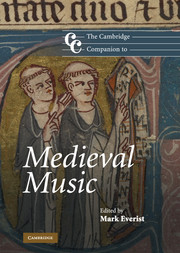5 - The fourteenth century
from Part I - Repertory, styles and techniques
Published online by Cambridge University Press: 28 September 2011
Summary
Although a famous popular history book's subtitle glossed the fourteenth century as ‘calamitous’, a consideration of its music would probably see the period as a triumph. In part this is because the chief technology that gives us access to the past –writing – became more widely used for record keeping by this time. In particular, the special kind of writing used to record musical sounds –musical notation – reached a new level of prescription, describing relative pitches and rhythms more fully than before. As the fourteenth century paid more cultural attention to writing things down in the first place, more music books survive from this period than from any earlier centuries, and their contents seem tantalizingly decipherable.
The detailed social and political history of the fourteenth century is complex and beyond the scope of this chapter. However, some of its aspects will be mentioned here, not in order to give a comprehensive history, but in order to suggest ways in which larger historical changes affected musical culture.
The later fourteenth century saw a deep division of the Western Christian church, a problem partly caused by the refusal of successive popes to reside in Rome after the French pope Clement V moved the papal court to Avignon (France) in 1309. The often lavish papal court was responsible for employing a large number of expert singers, many of whom we know to have also been composers because pieces by them survive.
- Type
- Chapter
- Information
- The Cambridge Companion to Medieval Music , pp. 87 - 104Publisher: Cambridge University PressPrint publication year: 2011



